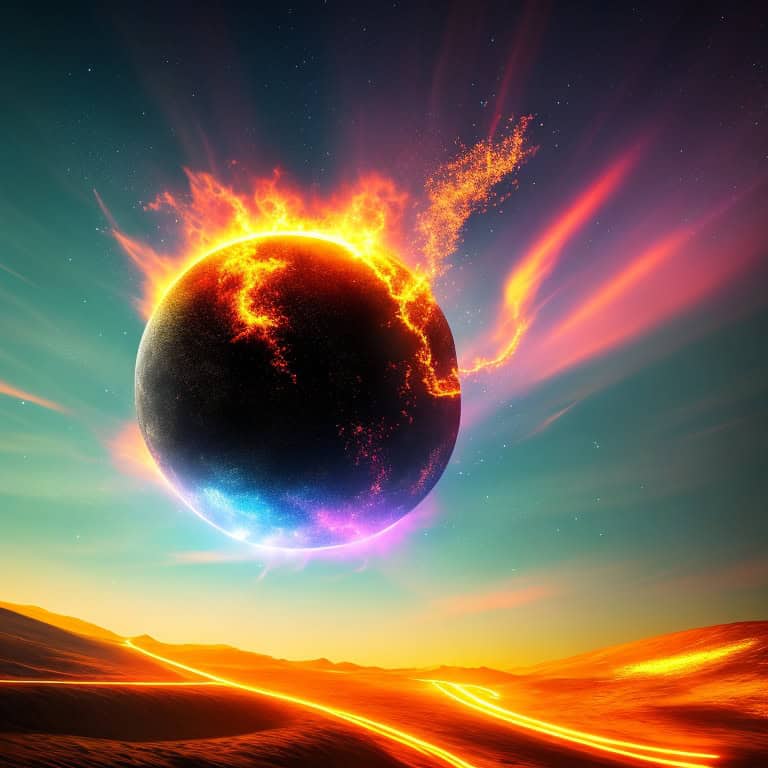
In the coming 30 days, observers will have the opportunity to witness a "Blood Moon" eclipse, the "Comet of the Century," and a "Ring of Fire" eclipse.
Over the next 30 days, the night sky will feature three remarkable astronomical events. This week, a lunar eclipse referred to as a “blood moon” is set to occur, followed later this month by the arrival of the “comet of the century,” and on October 2nd, a solar eclipse described as a “ring of fire” will take place. It’s quite extraordinary for such significant celestial occurrences to align so closely in time. Additionally, these astronomical signs emerge as our world faces profound turmoil.
On Tuesday evening, an exceptional event will unfold. It’s a rare occasion to experience a partial lunar eclipse coinciding with a “supermoon.” Make sure to look up on Tuesday for an extraordinary full moon experience.
The harvest moon, marking the closest full moon to the autumnal equinox, will manifest as a supermoon, appearing both larger and more luminous. As if that weren't enough, a partial lunar eclipse will also occur.
This full moon and the lunar eclipse are set for Tuesday night, September 17, extending into Wednesday morning. Reports indicate that during this partial eclipse, the moon will adopt a striking “blood-red” hue.
For stargazers, the moon will be 14 percent larger than usual, casting a haunting autumnal glow. The red colour, known as a blood moon, is typically visible during partial or total lunar eclipses. This dual phenomenon will be observable across Europe, South America, Africa, and much of North America.
The blood-red moon will be visible to a large portion of the western world. Following that, a magnificent comet, referred to by astronomers as “the comet of the century,” will make an appearance in the night sky, starting in late September. Known as C/2023 A3, or Tsuchinshan–ATLAS, this comet is expected to dazzle observers during September and October 2024. Astronomers anticipate that it will be extraordinarily bright, akin to Halley’s comet in 1986 or NEOWISE in 2020. Remarkably, it is expected to be visible without the need for a telescope. Reports indicate that this comet will reach its peak brightness on October 2nd.
C/2023 A3 will be observable in the Northern Hemisphere from September 27 until the final week of October, coinciding with its closest approach to the sun before it embarks on its journey back out of the solar system. According to Cometography, a specialized blog, October 2 will mark the day when C/2023 A3 will shine the brightest, and its tail will be both long and stunning due to its proximity to the sun.
Now, this is starting to feel quite strange. Do you recall what else is set to happen on October 2nd? For those who might not remember, there will be a "ring of fire" Rosh Hashanah eclipse that day. This annular solar eclipse, referred to as the “ring of fire,” is merely a month away. While Hawaii will be the only U.S. state to experience a partial view, the whole eclipse will be visible in parts of Chile and Argentina, with several other South American nations seeing either partial or full effects.
So, to clarify, a “ring of fire” solar eclipse will coincide exactly with the day when “the comet of the century” reaches its brightest. All of this will unfold just as the Rosh Hashanah festival begins. As I mentioned in an earlier article, there will only be two solar eclipses in 2024, both occurring on significant dates.
What is the reason that solar eclipses often coincide with significant dates? In 2024, there will only be two solar eclipses in total. The first one occurred on April 8th and is referred to as the “Great American Eclipse of 2024,” happening just after sunset in Israel, coinciding with the start of the first day of the first month in the Hebrew calendar. The second eclipse is scheduled for October 2nd, when it will also be shortly after sunset in Israel, marking the beginning of the Rosh Hashanah festival.
Recently, numerous remarkable eclipses have taken place, yet a large portion of the population remains oblivious to them. Additionally, many individuals seem unaware of the growing instability of our planet.
On Monday, southern California experienced yet another significant earthquake. According to the United States Geological Survey, a magnitude 3.6 quake was recorded early Monday, making it the second tremor in the area in less than five days. This earthquake occurred to the west of Los Angeles, with its epicentre located approximately 3.5 miles north of Malibu, as reported by the USGS.
Moreover, along the northern North American coast, a magnitude 6.5 earthquake was reported. The United States Geological Survey stated that this tremor struck off the shores of Port McNeill, a coastal town in British Columbia, Canada, on Sunday.
According to the USGS, the earthquake's epicentre was located in the Pacific Ocean, approximately 10 km (6.2 miles) beneath the ocean floor.
Why is it that more people don’t seem to grasp what’s unfolding?
As I mentioned a few days ago, seismic activity in California is truly setting records, yet very few individuals appear to be worried.
While those in the Southern Hemisphere may feel sorry for those in the Northern Hemisphere, I will bring your attention to the incredible number of earthquakes that have been shaking an area from the south Island of New Zealand all the way up to Fiji. With the North Island of New Zealand having 100 quakes a day. This has been happening for months.
With the prophecies of a great volcanic eruption striking New Zealand getting ever closer.